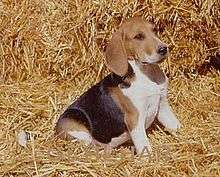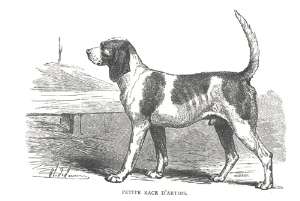Artois Hound
|
Artois Hound | |||||||||||||
| Other names |
Chien d’Artois Picard Briquet | ||||||||||||
|---|---|---|---|---|---|---|---|---|---|---|---|---|---|
| Origin | France | ||||||||||||
| |||||||||||||
| |||||||||||||
| Domestic dog (Canis lupus familiaris) | |||||||||||||
The Artois Hound is a rare breed of dog, and a descendant of the Bloodhound. A scent hound 22-23 inches high at the withers, weighing anything between 55 and 65 pounds, it is a well constructed dog with a slow graceful gait. It has a large, strong head, a medium-length back and a pointed tail that tends to be long and sickle-shaped. Their ears are set at eye level; they have large prominent eyes and quite thick lips.[1]
Characteristics
Appearance
A well constructed dog, muscled and not too long, giving the impression of strength and energy.
Head

- Cranial Region: Its skull should be strong, broad, quite short, rounded and flat at its upper part but with the occipital protuberance only slightly pronounced. Its stop should be accentuated.
- Facial Region: Its nose should be black, strong, with wide opened nostrils. Its muzzle should be straight and, seen in profile, moderately elongated. Of its lips, the upper lip should largely be covering the lower lip and must be rather important so as to give a square shape to the extremity of the muzzle, (as seen in profile). Its jaws/teeth should have a scissor bite, the upper incisors covering the lower in a narrow contact and are well set squarely in relation to the jaws. Its eyes, in relation to the width of the forehead, should not be very close together; they should be round, level with the head surface, with a melancholic and soft expression; they are dark brown in colour. The mucous membranes of the lower lids must not be visible. Its leathers should be set at eye level, a little thick, broad, round at the tip, almost flat and quite long, reaching the beginning of the nose. Its neck is moderately long, powerful; very little dewlap.
Body
Its back is broad and well supported. Its loins are slightly arched. The hips give a slight inclination to its croup, which is well muscled. Its chest is broad and long, rather let down so that the sternal line arrives at elbow level. Its ribs should be well sprung. Its belly flanks fully its body.
Tail
It is strong and quite long; there should be some longer and coarser, slightly offstanding hairs, (like ears of grain) towards the tip. It is carried in a sickle fashion, never falling forward.
Limbs
Forequarters
A view of the ensemble indicates that its limbs are strong and vertical. Its shoulders are oblique and muscled. Its elbows are set well in the axis of the body. Its forearm should be lightly oblique.
Hindquarters
A view of the ensemble indicates that, (seen from behind), the point of the buttock, the middle of the leg, the hock, the metatarsal and the foot are on the same vertical line. Its upper thighs are let down and well muscled. Its hock joints are strong and moderately angulated, and the metatarsals are short and strong.
Feet
They are slightly elongated, strong but sufficiently tight; the pads are black, tough and compact.
Coat and colour
Its skin is quite thick. Its hair is short, thick and quite flat. The coat pattern is a dark fawn tri-colour, (similar to the coat of a hare or a badger), with a mantle or in large patches. The head is usually fawn, sometimes with a black overlay. Its main colours being tan and black and white in any combination.
Temperament
The Artois Hound is an energetic dog that is brave and loyal. Though it has a large amount of endurance, it is calm and well balanced. It is a moderate sized dog that will feature the best characteristics of the scenthounds. It has a powerful sense of smell, and it is fast and independent. These dogs were bred to hunt rabbits, and they are proficient at this task. These dogs need to be trained by owners who are consistent. They are affectionate and loving to those that care for them. Like all scent hounds they are happiest when on the trail of a good scent.
Hunting
The Artois Hound, (a Briquet, (of a small type)), is nowadays used especially in hunting with guns, and on horseback. It drives the game closer taking advantage of their faults with ingenuity; its speed is average but maintained.
- In general countryside : Because of its acute sense of smell, it is capable of outmanoeuvring many of its prey's tactics.
- In woodland areas : With its ancestral qualities of a hunter, in sparse and well scattered groups of tall trees, it can hunt a deer efficiently, and in the desired direction of its owner.
- In the thicket : its intrepidity and bravery means that it can stir up and even the most obstinate boars.
- Additional points: It is a robust animal with a high pitched call which can be heard from as far away as 2 km.
Health Problems
There are no known health problems that are specific to the Artois Hound. Any health problems it may develop can be found in most other dog breeds. These dogs may have a maximum life expectancy of 13 years.
Care
Exercise
This is a hunting dog that needs extensive amounts of exercise. Without it, the dog could become problematic for its owners. It should be taken on walks daily, and this dog is great for healthy people who love to jog and hike. While it can live in an apartment, it may perform better in a small yard. It is important for owners to make sure this dog is never unleashed in an unsecured area, as it may run off in the direction of the first interesting scent it picks up. It is important for owners to make sure these dogs are given lots of space to move around in.
Grooming
The Artois Hound does not require a large amount of grooming. The Artois' smooth short-haired coat is easy to look after. Owners will simply want to make sure the coat is brushed on a consistent basis. These dogs should only be given baths when they need it. A wipe down with a damp towel should suffice for the bathing aspect, (although you should bathe it with mild soap only if or when necessary; you should also dry shampoo it occasionally), however a rubber, wire, or hard bristled brush would work best for the brushing aspect.The shedding patterns of these dogs are not known. Be sure to check the ears carefully for signs of infection. The nails of the D'Artois should also be trimmed, (particularly to avoid nail-born infections).
History
This breed, formerly named Picard, was much appreciated in ancient hunting at the time of Henry IV of France and Louis XIII of France, and much sought after. Selincourt already made much of it, wondering and amazed to see these dogs pulling a hare which had passed by one hour ago in dry weather. Le Couteulx de Canteleu, in Manuel de Vénerie Française (1890), (Manual of French Hunting - 1890), praises also the Artois hound. He reports that the artesian breed of his time was crossbred and difficult to find pure but, in spite of that, it still remained one of the best breeds for hare hunting. Northern France, bordering the English Channel, consists of the historical regions of Artois Hound. Hounds from this region stem from some of the earliest types.

The Artois Hound was a favorite by the 17th century. The Prince Alexandre de Gray wrote to the Prince de Galle, in 1609, of his intention to "send a pack of little d'Artois dogs to the king ..." In fact, this small French hound may have contributed to the formation of the Beagle in England.
By the 19th century it became popular among French hunters to avail themselves of the dogs from the British Isles. With the importation of many British types, the inevitable crossbreeding resulted in the deterioration of the pure Artois Hounds. Crossing also took place with the taller, more elegant, longer, scroll-eared hounds called Normands (now extinct). During the 19th century, only the packs kept at Chantilly and those of the Prince de Conde retained the ancient type.
In the 1880s, Ernest Levair and his cousin, M. Therouanne, began a 20-year effort to breed the original d'Artois, removing the last of the Normand blood.
Their efforts resulted in great success. At the end of the 19th century and at the beginning of the 20th, M. Levoir in Picardy had attempted the re-establishment of the old Artois type without really succeeding. During that period and until the beginning of the First World War, it was another Picard breeder, Mr. Mallard, who dominated the raising of the breed. But if he produced very pretty dogs, as witnessed by his numerous awards in canine shows, they were not always in the type conformed with the description given by contemporary authors. For all their efforts however the Second World War was very damaging for the breed and after the Second World War, it was believed that the Artois was all but extinct.
By the middle of the 20th century the breed had nearly disappeared, however in the 1970s a few aficionados[1] , in particular Mr. Audrechy, (of Buigny les Gamaches in the Somme), decided to reconstitute the breed from a few remaining specimens which they located after along search. Thanks to their efforts the modern day Artois hound closely resembles the original. There are now about 500 dogs registered in their stud books, making a strong comeback since 1975.
Notes
Note that the Artois Hound does not yet have Breed standards or classifications in any organisation, other than the FCI.
See also
References
- 1 2 Arthus-Bertrand, Yann (1993). Dogs. Cassel & Co. p. 384. ISBN 0-304-35630-1.
Other References
- Cassell, The Book of the Dog
- Bonnie Wilcox and Chris Walkowicz, The Atlas of Dog Breeds of the World.
External links
- http://www.furrycritter.com/resources/dogs/Artois_Hound.htm
- https://web.archive.org/web/20050425045728/http://www.aniwa.com:80/renvoie.asp?type=1
- http://www.ban-artois.org/ The Artésien Normand Basset and Chien d'Artois Club. France.